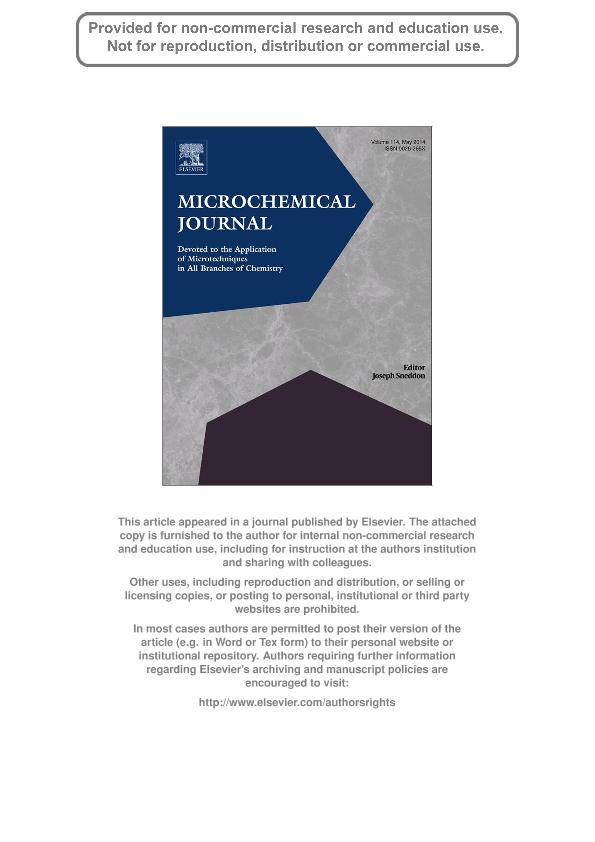Mostrar el registro sencillo del ítem
dc.contributor.author
Harguinteguy, Carlos Alfredo

dc.contributor.author
Fernandez Cirelli, Alicia

dc.contributor.author
Pignata, Maria Luisa

dc.date.available
2017-08-16T19:03:20Z
dc.date.issued
2014-04
dc.identifier.citation
Harguinteguy, Carlos Alfredo; Fernandez Cirelli, Alicia; Pignata, Maria Luisa; Heavy metal accumulation in leaves of aquatic plant Stuckenia filiformis and its relationship with sediment and water in the Suquía river (Argentina); Elsevier Science; Microchemical Journal; 114; 4-2014; 111-118
dc.identifier.issn
0026-265X
dc.identifier.uri
http://hdl.handle.net/11336/22534
dc.description.abstract
In order to evaluate the Stuckenia filiformis plant species as an indicator organism of heavy metal pollution in biomonitoring studies of the aquatic ecosystem, the aim of this study was to determine the levels of heavy metal accumulation (Co, Cu, Fe, Mn, Ni, Pb and Zn) in leaves of the submerged macrophyte S. filiformis and the possible relationship of the concentrations of these metals with those found in surface water and sediment samples of the Suquía river. Sampling was carried out in July 2006 and February 2009, during the dry and wet seasons, respectively, at 7 sampling siteswhere three replicates of surfacewater, sediment and S. filiformis plants were collected. Cobalt, Ni and Zn in surfacewater were significantly higher in the samples collected in 2006 than those in 2009. In sediment, the concentrations of Co, Cu, Ni, Pb and Zn, along with organic matter, were significantly higher in 2006, while those of Fe were significantly greater in 2009. Copper and Pb exceeded the limitsestablished for the protection of aquatic life by national (Cu: 2.0 μg L−1, Pb: 2.0 μg L−1) and international organizations (Cu: 1.6 μg L−1, Pb: 2.5 μg L−1) in surface water, while in sediment, Zn exceeded the limit for ecological screening levels (Zn: 121.0 mg kg−1) in 2006. In the surface water and sediment samples, heavy metal concentrationswere found to be higher downstream of Córdoba city (Sites 6 and 7) in both sampling campaigns, probably related to the contribution of pollutants from the effluent discharge of a wastewater treatment plant and industrial activities of the city. The aquatic plant S. filiformis showed a high capacity to accumulate heavymetals in its tissues, in areas of the riverwhere higher values of heavymetals in the abiotic compartmentssurface water and sediments were observed. Copper, Pb and Zn incorporated as contaminants in surface water and sediments were able to be removed by S. filiformis by self-purification processes. Therefore, this speciescould be proposed as a suitable heavy metal bioindicator for the early stages of pollution in rivers.
dc.format
application/pdf
dc.language.iso
eng
dc.publisher
Elsevier Science

dc.rights
info:eu-repo/semantics/openAccess
dc.rights.uri
https://creativecommons.org/licenses/by-nc-sa/2.5/ar/
dc.subject
Stuckernia Filiformis
dc.subject
Bioaccumulation
dc.subject
Heavy Metals
dc.subject
Suquia River
dc.subject
Argentina
dc.subject.classification
Oceanografía, Hidrología, Recursos Hídricos

dc.subject.classification
Ciencias de la Tierra y relacionadas con el Medio Ambiente

dc.subject.classification
CIENCIAS NATURALES Y EXACTAS

dc.title
Heavy metal accumulation in leaves of aquatic plant Stuckenia filiformis and its relationship with sediment and water in the Suquía river (Argentina)
dc.type
info:eu-repo/semantics/article
dc.type
info:ar-repo/semantics/artículo
dc.type
info:eu-repo/semantics/publishedVersion
dc.date.updated
2017-08-01T13:58:17Z
dc.journal.volume
114
dc.journal.pagination
111-118
dc.journal.pais
Países Bajos

dc.journal.ciudad
Amsterdam
dc.description.fil
Fil: Harguinteguy, Carlos Alfredo. Consejo Nacional de Investigaciones Científicas y Técnicas. Centro Científico Tecnológico Conicet - Córdoba. Instituto Multidisciplinario de Biología Vegetal. Universidad Nacional de Córdoba. Facultad de Ciencias Exactas Físicas y Naturales. Instituto Multidisciplinario de Biología Vegetal; Argentina
dc.description.fil
Fil: Fernandez Cirelli, Alicia. Universidad de Buenos Aires. Facultad de Ciencias Veterinarias. Centro de Estudios Transdisciplinarios del Agua; Argentina. Consejo Nacional de Investigaciones Científicas y Técnicas; Argentina
dc.description.fil
Fil: Pignata, Maria Luisa. Consejo Nacional de Investigaciones Científicas y Técnicas. Centro Científico Tecnológico Conicet - Córdoba. Instituto Multidisciplinario de Biología Vegetal. Universidad Nacional de Córdoba. Facultad de Ciencias Exactas Físicas y Naturales. Instituto Multidisciplinario de Biología Vegetal; Argentina
dc.journal.title
Microchemical Journal

dc.relation.alternativeid
info:eu-repo/semantics/altIdentifier/url/http://www.sciencedirect.com/science/article/pii/S0026265X13002609
dc.relation.alternativeid
info:eu-repo/semantics/altIdentifier/doi/https://doi.org/10.1016/j.microc.2013.12.010
Archivos asociados
